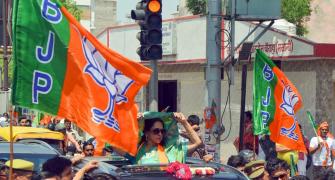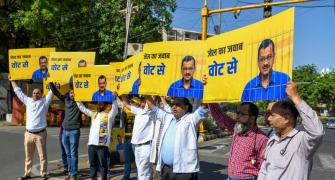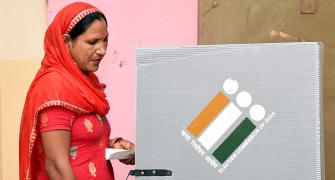While direct taxes have been growing at an average of 25 per cent for the last three years, the Central Board of Direct Taxes continues to work on several proposals to both improve the quality of service offered to taxpayers (such as timely refunds) as well as to find ways to improve tax compliance.
CBDT Chairman B M Singh spoke to Prashant Sahu about some issues. Excerpts:
Will direct tax collection growth be even faster this year?
The growth of over 39 per cent in direct taxes during fiscal 2006-07 was unprecedented. In the preceding three years, the growth rates were 26.5, 26.3 and 24.4 per cent respectively -- this works out to an average of about 25 per cent. In the current fiscal, we have been seeing growth rates of over 40 per cent. We expect this to continue.
What is the CBDT doing to improve taxpayer services?
We have taken several steps to improve taxpayer services. The Large Taxpayer Unit (LTU) scheme was launched in Bangalore for large taxpayers. The scheme will be extended in a phased manner to other cities. It will be in place in Chennai shortly, and we will implement it in Mumbai and Delhi after that.
The Tax Return Preparer scheme has been launched and the first batch of over 3,700 TRPs have been trained to help small and medium taxpayers file their returns. There is a good response to the scheme and we hope to train more TRPs in the future.
The Refund Banker scheme was launched in the salary Commissionerates of Delhi and Patna. It was later extended to other non-corporate Commissionerates in these two places. The response is positive and we shall extend the scheme to other cities like Mumbai, Chennai, Kolkata and Bangalore.
What about computerisation and e-payment of taxes?
We are in the last leg of our comprehensive computerisation process. The national network connecting 745 locations in 510 cities and towns across India is in place. The National Data Centre and makeover of the applications system from a two-tier server-client architecture to a three-tier architecture will commence shortly and be completed by the end of this fiscal.
After the new architecture is in place, returns will be processed in central processing centres in the four metros and Bangalore to enable speedier processing of returns and prompt issue of refunds.
The facility of electronic filing of tax returns was made available to facilitate filing of tax returns without visiting the tax office. This has now been made compulsory for corporate and other large taxpayers. E-payment of taxes, currently available through five banks, will be introduced at all the agency banks authorised to collect direct taxes with effect from January, 2008.
What is the CBDT doing to reduce litigation in transfer pricing, an area of major disputes between your department and corporates?
Since transfer pricing is a new law introduced in 2001, there are bound to be disputes. The workload of transfer pricing audits is increasing due to increasing international collaborations, FDI, M&As and
We have recently strengthened the Directorates of International Taxation and Transfer Pricing. These are new areas of taxation and the law is still evolving.
Is the investigation into the 2003-05 IPO scam complete? What are the findings?
The investigation is complete and the investigation report submitted. Information contained in the investigation reports will be used for framing assessments after confronting the taxpayers, examining their replies and evaluating the evidence on record. Cases will be reopened wherever necessary.
How many tax returns were filed through TRPs in July? Was the scheme successful?
We are awaiting a feedback on the scheme and hope to train more TRPs in the future.
What is the initial estimate of the number of tax returns filed by non-corporates till July 31?
We have received about 1.42 crore returns till August 31 this year as compared to 1.38 crore returns last year. Out of these, about 1.46 lakh taxpayers filed e-returns voluntarily as against only about 3,000 voluntary e-returns last year.
Are you planning a Human Resources Management Directorate with a legal wing? How it will serve the department?
The Directorate will help develop in-house advocacy skills so that the domain knowledge of the officers is utilised effectively in handling matters before tribunals and courts.
What is business process re-engineering all about?
The department is going through a comprehensive business process re-engineering (BPR) exercise, involving the examination of processes, procedures, human resource and technology needs of the department.
The BPR study has focused on the four core areas of functioning of the department, viz, pre-assessment, assessment, post-assessment and appellate/dispute resolution processes. Based on the study, the BPR consultant will roll out deliverable plans to ensure an effective changeover from the old to the new process environment.
What is being done to deepen and widen the tax base?
Several steps have been taken to widen and deepen the tax base. The ambit of Tax Deduction/Collection at source (TDS/TCS) has increased over the years. Creating new TDS charges and increasing its strength have strengthened the TDS mechanism. E-filing of TDS/TCS returns has been made compulsory.
The system of filing of Annual Information Returns relating to high-value transactions was introduced two years ago. Some cases are selected for scrutiny on the basis of information collected from AIRs.
New taxes like Banking Cash Transaction Tax and Securities Transaction Tax have been introduced, creating audit trails and resulting in new avenues of investigation and scrutiny of tax returns.
A Computer-Aided Scrutiny Selection system was introduced to make the scrutiny selection process non-invasive and non-discriminatory. The system is being further developed to select cases for scrutiny based on risk assessment. Data-mining software has been developed for this purpose.
The combined impact of these steps has contributed to robust growth in direct tax revenues.








